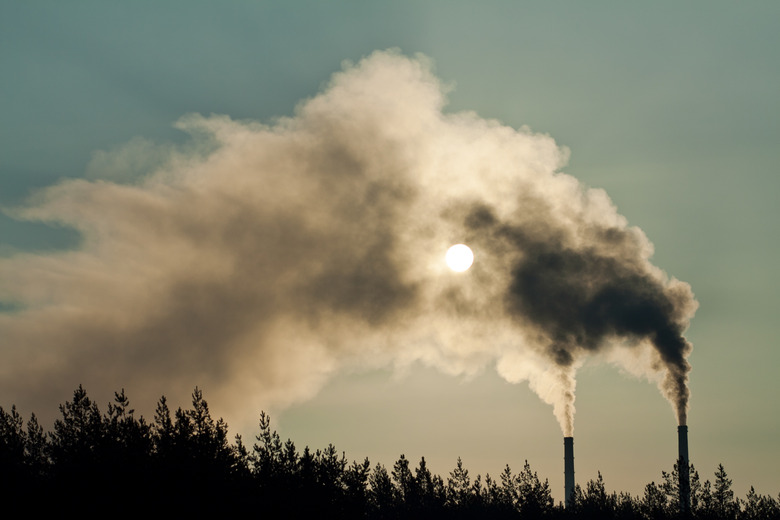Human Impact On The Earth's Atmosphere
Like children playing in the mud, humans have dirtied the Earth's atmosphere and environment in multiple ways. The Industrial Revolution sparked a huge advance in technology and development, but it led to air pollution and contaminants being released into the air. The human impact on the Earth's atmosphere and climate remains a major issue in ecological politics today, and presents a problem that could threaten the planet for years.
TL;DR (Too Long; Didn't Read)
Even if humans quit polluting the atmosphere by reducing carbon dioxide releases right now, it still could take more than a century before the air clears. Atmosphere pollution affects the Earth for the long-term. Pollution will last well beyond the humans alive on the planet today.
Greenhouse Gases
Greenhouse Gases
Greenhouse gases, such as carbon dioxide and methane, contributes to the greenhouse effect, which causes the atmosphere to trap heat, making temperatures rise in the oceans and on the planet. According to the U.S. National Oceanic and Atmospheric Administration, the concentrations of carbon dioxide in the atmosphere have increased by 38 percent since 1750, while methane concentrations have gone up 148 percent during the same period. Most scientists attribute this increase to the widespread combustion of fossil fuels.
Depleted Ozone Layer
Depleted Ozone Layer
The ozone layer, a protective covering of the atmosphere, helps to block ultraviolet radiation. In May of 1985, scientists from the British Antarctic Survey discovered that something was destroying ozone molecules above Antarctica. Study of the problem traced the destruction to chlorofluorocarbons and other ozone-depleting chemicals, and in 1987, countries around the world signed the Montreal Protocol to discontinue the use of CFCs. CFCs include chemicals typically found in aerosol sprays, in refrigerants used in air conditioners and in blowing agents for foam and other packing materials.
Air Pollution
Air Pollution
Humans also affect the atmosphere locally through air pollution. Compounds released by fossil fuel combustion often create ozone molecules at the ground level. This poses a threat to people with breathing difficulties, and can damage the lungs with long-term exposure. The EPA regularly publishes air quality alerts for affected areas, and advises people with breathing difficulties or environmental sensitivities to stay inside on days where ozone concentrations are highest.
Long-Term Effects
Long-Term Effects
Even after banning certain chemicals or cleaning up the air, it will take some time for the atmosphere to heal. Even though CFCs were banned in the U.S. in 1985, their molecules live a long time in the atmosphere. The British Antarctic Survey estimates that the hole in the ozone layer may take as many as 50 years to disappear, provided no new threats to the ozone come into play.
In the same way, the Earth's ecosystem re-absorbs carbon dioxide from the atmosphere very slowly, which means that even stabilizing CO2 output levels may not be enough to prevent major atmospheric changes. Studies by the Intergovernmental Panel on Climate Change suggest that even if human beings cut carbon output levels by 50 percent, the Earth would still see a net increase in atmospheric carbon dioxide over the next century due to the changes already in motion.
Cite This Article
MLA
Kazmeyer, Milton. "Human Impact On The Earth's Atmosphere" sciencing.com, https://www.sciencing.com/human-impact-earths-atmosphere-3677/. 23 April 2018.
APA
Kazmeyer, Milton. (2018, April 23). Human Impact On The Earth's Atmosphere. sciencing.com. Retrieved from https://www.sciencing.com/human-impact-earths-atmosphere-3677/
Chicago
Kazmeyer, Milton. Human Impact On The Earth's Atmosphere last modified March 24, 2022. https://www.sciencing.com/human-impact-earths-atmosphere-3677/
